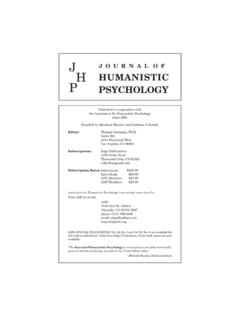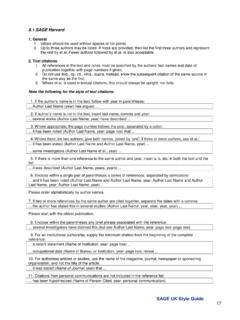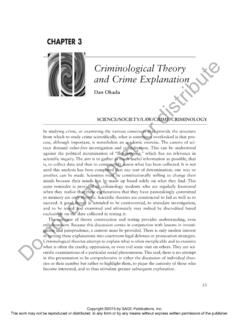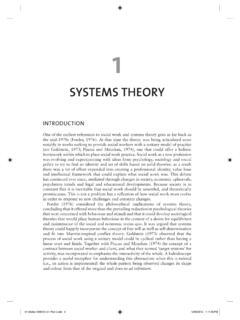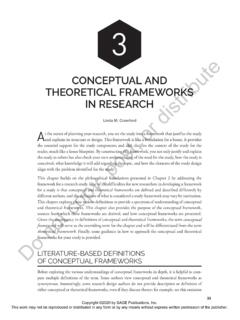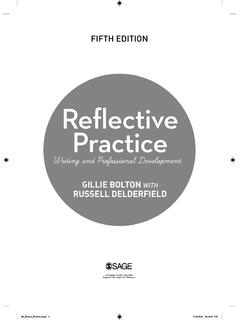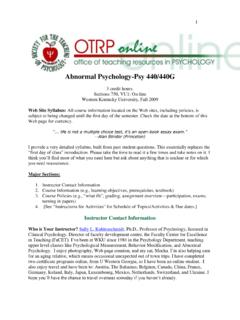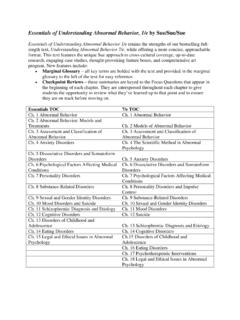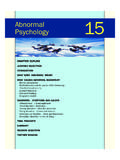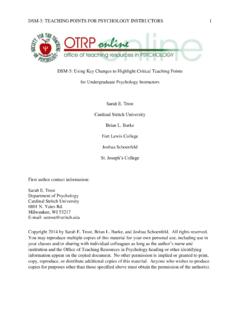Transcription of Defining Abnormal Behaviour - SAGE Publications
1 Defining Abnormal Behaviour1 Learning aimsAt the end of this chapter you should:x Understand the complexity in distinguishing between Abnormal and normal Behaviour x Understand the various definitions of Abnormal Behaviour x Be familiar with the differences between deviance and dysfunctionx Comprehend the complexities of legal definitions and STUDYMatt is a 42-year-old construction worker. He has been married for 20 years, has two nearly grown children, served four years in the military and has been employed at the same construction company since he left military service. He is described as steady and reliable. Yet, there is one thing that 127/03/2013 8:03:12 PM2 Understanding Abnormal Psychology2doesn t seem quite right; he carries small brass bells with him wherever he goes. He has carried these bells since he was a child and will tell people that they are for luck. The reality is that Matt carries them to keep evil spirits away.
2 He stopped telling people his real reason for carrying bells because people were less understanding than if he just said he carried them for luck. Matt s beliefs do not interfere in his life, he has never been treated for a mental illness, and he doesn t appear to use them to control anything else in his life. His Behaviour has made him the butt of jokes. He has been called harsh names; he has been physically and mentally abused by others and yet he continues to carry his bells. Time has taught him to hide them in his clothing and he has taken to sewing them in the seams of his shirts and trousers. How would you describe Matt s Behaviour ? Is Matt mentally ill?WHAT IS Abnormal Behaviour ?What is Abnormal Behaviour ? How do we define what is Abnormal ? We can identify Behaviour that is weird when we see it but how do we define it. The majority of us avoid what we define for our-selves as odd Behaviour , for example we would probably choose not to sit next to someone acting in an odd fashion or dressed in odd clothing on a bus or train.
3 We don t like individuals who smell unclean and whenever possible stay away from them. On the whole, we would define abnormality as being outside the parameters of what is accepted in our society. But how is this defined and what does normal parameters really mean? Who decides what is Abnormal vs. normal? If normal Behaviour is defined by a society, what is a society?A society is a collective of individuals who are defined by the language that is spoken, religious practices and ethnic diversity. Societies are fluid and constantly changing. What was the norm for a society one hundred years ago may not be the norm of the same society today. How an individual behaves within a group is defined by the constraints of the society. Rules and norms govern what are deemed to be normal parameters. If you lived a solitary existence, how you behaved would not be dictated by others as you would be free to do as you chose. Your Behaviour would not impinge on anyone else.
4 When an individual lives within a group, the definition of normal Behaviour is usually classified by a consensus of what is considered to be normal for that group. Occasionally, certain groups of people can push the boundaries but even this has limitations. For example, many normal behaviours are classified by age ranges. A 16-year-old who chooses to dye their hair a bright lime green colour would probably not be classified as Abnormal ; perhaps unusual, but not extreme. We would probably agree that this Behaviour is pushing the boundaries, but we would also define it as youthful Behaviour and therefore acceptable. However, if a 70-year-old engages in the same behav-iour, our evaluation of this individual would be outside of normal boundaries. The norms that gov-ern Behaviour at different age categories have unwritten rules that guide Behaviour . Although it is certainly not illegal to dye hair any colour, at any age, certain colours would be governed by rules of what is considered age-appropriate Behaviour and anyone acting outside these boundaries would probably be classified as behaving in an Abnormal way.
5 This is also complicated by the number of inappropriate behaviours . If the only Behaviour that is outside of the norm, lime green hair, and 227/03/2013 8:03:12 PM3 Defining Abnormal Behaviour all other behaviours are age appropriate and considered normal, the unusual element may be clas-sified as odd or eccentric. The single Behaviour displayed with all else being normal may not be defined as Abnormal , although it would probably never be considered normal. The consequence of having odd hair would probably result in those individuals within the same age range ostracizing the individual until they changed their hair back to an age-appropriate colour. So, what is Abnormal psychology and how do we determine that people are behaving in Abnormal ways? Do we define abnormality by the number of extreme behaviours ? Efforts to define psychological abnormality typically raise as many questions as they answer. Ultimately, a society selects general criteria for Defining abnormality and then utilizes that criterion to judge particular cases.
6 Szasz (1960) believed that the entire idea of abnormality and mental illness was invalid and what society defines as Abnormal are simply problems in living or finding a niche, not that something was wrong with the individual. Other researchers have believed that the concept of mental illness is used to control or change people whose unusual patterns of functioning upset or threaten the social order (Sarbin & Mancuso, 1980; Scheff, 1966). These viewpoints may seem extreme and hardly anyone would argue that the pressures of being successful and attaining one s goals in society do not contribute to stress and dysfunctional behav-iour, but how do we define this contribution and more importantly, what can we do to change the pattern? Perhaps it is important to look at how the past has defined Abnormal Behaviour . History has pro-vided us with examples of Behaviour that has been defined as Abnormal for that society and that time and place. It may be important in our search for meaning to begin with earlier examples of what was defined as Abnormal to help us understand how we classify Abnormal Behaviour today.
7 Society sdefinitionIndividualself-conceptlack of fitin societythe result is mental illnessSzasz s idea of abnormalityFigure 327/03/2013 8:03:13 PM4 Understanding Abnormal PsychologyHISTORICAL PERSPECTIVES OF Abnormal BEHAVIOURA ncient societies believed that events and people were controlled by the supernatural and when individuals in the community acted outside of what was considered normal they were then placed at the mercy of evil spirits that could cause affliction, inhabit their bodies or cause terrible events to happen to family members. History is filled with stories of individuals who intentionally exchanged their souls in order to obtain wealth and power. Therefore, ancient societies looked for physical evidence of evil and found it in anything that deviated from the norm (Millon, 2004). Physically and mentally abnormalities were proof of demonic possession. Individuals were generally held to be responsible for their own ailments or had committed some act to place family members in danger.
8 The treatments used by many early societies in order to purge the person from evil generally involved extreme physical measures in order to make the corporeal manifestation of the demon unpleasant and allow the evil spirit to leave the body. Unfortunately the extreme physical treat-ment often proved fatal but nevertheless was considered a success as it kept the rest of the commu-nity safe from harm (Porter, 2002).The idea that evil spirits were responsible continued for thousands of years, until Hippocrates, a Greek physician, began to change the way illness was perceived. Hippocrates believed that imbal-ances and disorders were not the result of evil spirits and instead were problems within the brain and body. He relied on observations and explanations which would be the beginning of the scien-tific method. Hippocrates greatly influenced medicine by shifting the ideology from corporeal to tangible.
9 He correctly assumed that the most important area of the body was the brain and that it was central to intellectual activity and Abnormal Behaviour was as a direct result of disease. Hippocrates introduced the theory of heredity and environmental factors into the concept of mental illness and developed more compassionate treatments which subjected individuals to less cruel and violent methods (Porter, 2002). Hippocrates was also the first to classify Abnormal Behaviour into three distinct categories; mania, melancholia and phrenitis, giving each detailed clinical descriptions. Others would follow the direc-tion that Hippocrates proposed. Plato continued the belief that Abnormal behaviours occurred as a result of brain and body dysfunction and would insist that these individuals should be cared for by their families and not punished for their Behaviour . Galen made major contributions with his sci-entific examination of the central nervous system and how this contributed to Abnormal Behaviour (Porter, 2002).
10 Just as mankind appeared to be striding forward, they took a gigantic step backward with the rise of Christianity. Religious dogma reinstated the ancient ideas that Abnormal Behaviour was the result of supernatural contact; however instead of random, unnamed evil spirits the culprit was the devil. Scientific attempts to understand, classify and explain became less important than accepting disease and dysfunction as a manifestation of God s will. The influence of Christianity did not promote science and instead actively discouraged it. Physicians were no longer allowed to conduct scientific experiments to determine the cause of death. Anyone who challenged Christian doctrine was denounced as a heretic and condemned. Initially, those who continued the teachings of Hippocrates and Plato were denounced and when 427/03/2013 8:03:13 PM5 Defining Abnormal Behaviour this proved an ineffective deterrent they were executed by the church and all their papers and books were seized and burned.
